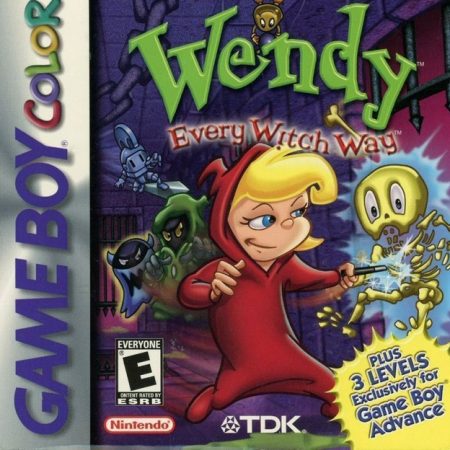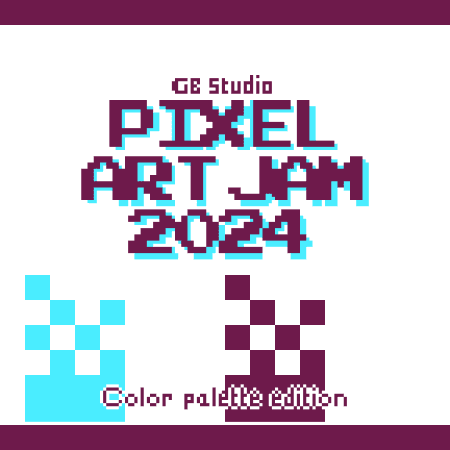Nine years before VVVVVV fell into our hands, a lesser-known game with a very similar gravity swapping mechanic dropped on the Game Boy Color. While this particular game isn’t as highly acclaimed as Terry Cavanagh’s platforming masterpiece, it’s certainly worthy of discussion here!
Developed by WayForward Technologies (of Shantae the Genie fame) and released in 2001 for the Game Boy Color, Wendy: Every Witch Way is a charming little action platformer featuring a side character from the Casper the friendly ghost comic book series.
As far as the story goes, the titular Wendy the Good Witch has mistakenly opened her aunts’ treasure chest, letting loose some magical stones and in the process, has broken the levitation spell on her aunts’ castle in the sky. Wendy must use her gravity flipping spell and her projectile shooting wand to pacify enemies and traverse the castle in search of these stones in order to correct her mistake. Pretty bare bones, but then again what more do you need from an action platformer? That being said, while Wendy: Every Witch Way’s story might lack a little flare, the game really shines when it comes to how the developers implemented enemy and obstacle design.
Let me ask you something, have you ever wondered what a plumber is doing surrounded by mushroom people as he battles a never ending army of turtle things? You have to admit, the Super Mario universe is really wild. That kind of imaginative world building can be extremely charming, but there is something to be said about designing around a theme too. Both in a thematic and a mechanical sense, Wendy: Every Witch Way‘s enemy designs all come together to form a very cohesive whole and end up complimenting the main gravity flipping mechanic extremely well.
Let’s take a look at some of these enemies in more detail, and we will see just how integrated all these design choices are to not only the core gravity flipping mechanic but also the games kid friendly fantasy aesthetic too.
So, let’s say you’re the developer of Wendy: Every Witch Way. You have just started brainstorming ideas for the first level and you need an enemy with a small hit-box so it’s not much of a threat to the player. What’s more, you’re going to need an enemy that won’t get in the way when the player is getting the hang of the gravity mechanic in those first minutes of game play too. In other words, it’s best if the enemy is slow to move and doesn’t fall on Wendy’s head while the player is trying to learn the basics. And if all that wasn’t enough, you’re going to need an enemy that belongs in a witch’s castle as well…
If you were thinking of a snail, then you would fit right in at WayForward Technologies circa 2000.
A snail is small, so a beginner player won’t find it too threatening (its hit-box is 8×16 pixels). Snails also move at … ahem … a snail’s pace, so it’s certainly easy to avoid with a simple jump. Snails are also slimy so it makes sense that it sticks to ceilings and won’t be affected by a pesky witch who’s bent on flipping gravity every few seconds. The player can bypass it completely by flipping the gravity and sneaking by unseen if they so choose. I’m pretty confident snails are a common ingredient in witches brews, so it would also make sense they are wandering around a dank castle owned by some witch.
Well then, that seems to settle it! What we end up with is an enemy that perfectly compliments the main gravity flipping mechanic and it’s mechanically designed to ease a beginner into the game play and it works aesthetically. A very fitting introductory enemy indeed. (If you were thinking of a tiny slime monster then that would be a great fit too!)
It’s not long before the player comes upon the next enemy – the Knight.
Being a knight, and not a slimy snail, this enemy can’t stick to ceilings and falls under gravity. Therefore, he will always end up on the same platform as the player, no matter what direction the gravity is falling. The player is now forced to deal directly with him. They will need to jump over the Knight or shoot magical wand projectiles to destroy him. Furthermore, coming in at 16×16 pixels, the Knights hit-box is twice the size of the snails and he is slightly faster. These mechanical properties of the knight make him a relatively harder enemy to deal with (Twice the size – twice as hard) and so we can start to see the beginnings of a difficulty curve at work.
By the time the player has reached level 1-2, they would by now have a decent grasp of the basics. So the developers up the ante with an all new enemy – the Pig Knight.
The Pig Knight is a considerably more difficult (and interesting) foe to deal with relative to what has been thrown at the player so far. Again, its hit-box is double that of the previous enemy, coming in at 32 pixels high and, while the player can jump over it, it’s starting to become a risky venture. The player will likely attempt to expunge the Pig Knight using Wendy’s magic projectiles. If they attempt this, they will find that tactic completely ineffective due to the fact that Pig Knight carts around a rather large shield that’s impervious to such attacks. Instead the player must solve the problem (and I’m sorry to spoil this moment if you haven’t played the game yet) by flipping the gravity, sending the pig through the air and stunning it upon crashing into the floor or ceiling. Only then can Wendy take out the enemy using her magic wand. So again, we have another well considered enemy that builds upon the gravity flipping mechanic and manages the difficulty curve in excellent fashion.
These are just the first three enemies in Wendy: Every Witch Way. There are many more to discover and all are just as well designed both in a mechanical and difficulty curve sense (the skeletons are my personal favorite!). The game also handles other details just as well. Off-screen information is hinted at using background art of chandeliers hanging from the ceiling and statues jutting out of the floor, signaling that a platform lies just beyond the edge of the Game Boy screen. The vibrant, high contrast color palettes make the moment to moment game play very easy to read and the final boss has a nice gravity switching puzzle element that makes for a satisfying conclusion.
While I think Wendy: Every Witch Way is a very well designed game, it’s not without at least a few shortcomings. With only sixteen levels on the Game Boy Color version, four of which are actually fairly straightforward side scrolling shmups, I didn’t lie when I said it was a charming little action platformer (to be fair, there is also a bonus world unlocked if you play the game on a Game Boy Advance). In any case, you can finish the game in a single sitting with ease. The designers could have explored the gravity mechanic in greater detail, added a few more bosses and tightened the shmup sections given more development time with this one. But all in all, it’s a strong entry in the Game Boy Color catalogue and worthy of any enthusiast’s attention – even if it is just for an hour or two on a lazy afternoon.

Independent Games Designer, Artist, Film Enthusiast and Full-time Dad (he/him). Check out my games here!





